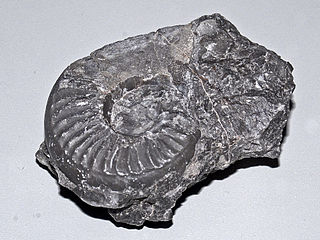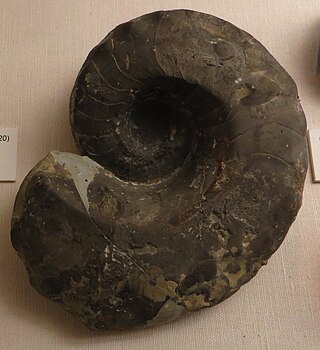
A perforation is a small hole in a thin material or web. There is usually more than one perforation in an organized fashion, where all of the holes collectively are called a perforation. The process of creating perforations is called perforating, which involves puncturing the workpiece with a tool.
Heminautilus is an extinct genus of nautiloids from the nautilacean family Cenoceratidae that lived during the Early Cretaceous. Fossils of Heminautilus have been registered in rocks of Barremian and Aptian age. Nautiloids are a subclass of shelled cephalopods that were once diverse and numerous but are now represented by only a handful of species.
Solenochilus, type genus of the Solenochilidae is an extinct cosmopotilian nautilid from the Lower Pennsylvanian to the Lower Permian with a rapidly expanding, coiled globular shell with few whorls, from which prominent spines extend laterally from the umbilical area at maturity. Solenochilus is derived from the Upper Mississippian Acanthonautilus, principally through evolutionary changes in the siphuncle.
Syringonautilidae is a family of Nautiloidea from the middle to late Triassic. Syringonautilidae comprise the last of the Trigonoceratoidea and are the source for the Nautilaceae which continued the Nautiloidea through the Mesozoic and into the Cenozoic right down to the recent. Syringonautilidae is a strictly Triassic family, derived early in the Triassic from the Grypoceratidae.

Grypoceratidae is the longest-lived family of the Trigonoceratoidea, or of the near equivalent Centroceratina; members of the Nautilida from the Upper Paleozoic and Triassic.
The Centroceratidae is the ancestral family of the Trigonoceratoidea and of the equivalent Centroceratina; extinct shelled cephalopods belonging to the order Nautilida
Tainonautilus is an extinct coiled cephalopod that lived during the Permian and Early Triassic which is included in the nautiloid family Tainoceratidae.
Aphelaeceras is an extinct genus from the nautilid family Trigonoceratidae which is part of the Trigonocerataceae, that lived during the Mississippian Period in the late Paleozoic.

Macrocephalites is a genus of the stephanoceratoid ammonite family Macrocephalitidae, diagnostic of the Callovian stage of the Middle Jurassic. Three subgenera, Dolikephalites, Kamptokephalites, and Pleurocephalites are recognized in addition to Macrocephalites itself, with Indocephalites tentatively included as the fourth.

Tainoceratidae is a family of late Paleozoic and Triassic nautiloids that are a part of the order Nautilida, characterized by large, generally evolute shells with quadrate to rectangular whorl sections. Shells may bear ribs or nodes, or both.
Thuringionautilus is a genus of large, moderately involute, nautiloids from the nautilid family Tainoceratidae. The whorl section is subquadrate, flanks slightly convex, venter broad with a median furrow. Ventral shoulders, narrowly rounded to subangular; umbilical shoulders, broadly rounded. Longitudinal nodes slope diagonally backwards on the venter toward the furrow. Suture, slightly sinuous. Siphuncle, subdorsal.
Holconautilus is a genus of nautiloids from the family Tainoceratidae and order Nautilida, named by Mojsisovics, 1902, and known from Upper Triassic sediments in Europe and E Indies (Timor). Its shell, evolute, discoidal, with simple coarse lateral ribbing; whorl section, subrectagular with a broadly arched venter.
Anoploceras is a genus of Middle and Upper Triassic nautiloids included in the Tainoceratidae, known from eastern Europe. The shell is evolute with only a slight overlap of previous whorls. Whorl section is subquadrate, like Pleuronautilus, only depressed. Flanks have conspicuous ribs that may be somewhat sinuous.
Enoploceras is a Tainoceratid genus, a nautiloid cephalopod in the order Nautilida, known from Triassic sediments in Europe, India, Timor, and the state of Idaho.

Deltocymatoceras is an involute cymatoceratid (Nautilioidea-Nautilida) with broadly arched whorl sides, strongly convergent on a narrow venter that bears a slight, rounded, keel-like ridge, and with no distinct ventro-latera shoulders. Sides bear cymatoceratid ribs that bifurcate near the middle of the whorl sides, but do not cross the venter. The suture has a somewhat pointed ventral saddle, broad lateral lobes and prominent saddles on the umbilical shoulders. The position of the siphuncle in undetermined.
Grypoceras is a coiled nautiloid cephalopod from the Triassic of western North America, southern Asia, and Europe that belongs to the nautilid family Grypoceratidae. Named by Alpheus Hyatt in 1883, the shell of Grypoceras is essentially involute with a subtriangular cross section, widest across the umbilical shoulders, with flanks fairing toward a narrow flattened venter. Sutures on flanks are with smooth, deep lobes and with shallow ventral lobes.

Germanonautilus is a cephalopod genus included in the nautilid family Tainoceratidae, found widespread in the Triassic of North America, Europe, Asia, and north Africa. The shell is a moderately involute nautilicone ; whorl section subquadrate to trapezoidal, widest across the umbilical shoulders, flanks flattened and ventrally convergent, venter flat and wide, dorsum narrowly and deeply impressed. The suture is with broad and deep lateral lobes and a shallow ventral lobe. The siphuncle is central and nummuloidal, composed of expanded segments that give a beaded appearance.

Cadoceras is an extinct ammonite genus belonging to the Cardioceratidae that lived during the Jurassic period from the late Bajocian to the early Callovian.
Solenochilidae is a small family of Carboniferous and Early Permian nautilids, similar and related to the Aipoceratidae that comprises genera with whorls in contact and which develop laterally projecting umbilical spines by maturity. The included genera Solenochilus and Acanthonautilus are quite similar in external form but differ in their siphuncles. Those of Solenochilus have more strongly inflated siphuncle segments and more tightly curved septal necks.

Cleviceras is an extinct genus of cephalopod belonging to the family Hildoceratidae. These cephalopods existed in the Jurassic period, during Toarcian and possibly even uppermost Pliensbachian age. Sometimes, it is considered to be a synonym of Eleganticeras.







